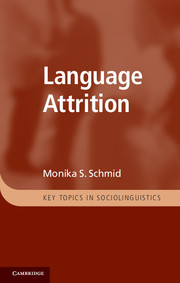Book contents
- Frontmatter
- Contents
- List of figures
- List of tables
- Preface
- Abbreviations
- 1 Introduction
- Part I Linguistic aspects of language attrition
- 2 What is attrition?
- 3 Cross-linguistic influence and the mental lexicon
- 4 Attrition in the mental lexicon
- 5 Attrition and the structure of language
- Part II Extralinguistic aspects of language attrition
- Part III Conducting research on language attrition – preliminary considerations
- Part IV Experimental designs for attrition research – the language attrition test battery
- Part V Coding and analysing the data
- 18 Conclusion
- Glossary
- Notes
- References
- Index
5 - Attrition and the structure of language
Published online by Cambridge University Press: 05 June 2012
- Frontmatter
- Contents
- List of figures
- List of tables
- Preface
- Abbreviations
- 1 Introduction
- Part I Linguistic aspects of language attrition
- 2 What is attrition?
- 3 Cross-linguistic influence and the mental lexicon
- 4 Attrition in the mental lexicon
- 5 Attrition and the structure of language
- Part II Extralinguistic aspects of language attrition
- Part III Conducting research on language attrition – preliminary considerations
- Part IV Experimental designs for attrition research – the language attrition test battery
- Part V Coding and analysing the data
- 18 Conclusion
- Glossary
- Notes
- References
- Index
Summary
What is the difference between lexical and grammatical, or structural, attrition? Can attritional processes affect the phonological and grammatical repertoire of a language? This chapter will look at these phenomena and show to what extent we may expect to find them in language attrition.
In the previous chapters, I have discussed ways in which language attrition may affect the lexicon of a language. I have pointed out that the lexicon of the average speaker consists of thousands of items, changes quickly even in predominantly monolingual communities, and often overlaps a great deal between languages. It is therefore not surprising that we often find indications of change, both due to CLI and to attrition, in the lexicon of attriters.
The situation is quite different when it comes to those things that we normally consider part of linguistic structure: phonology and phonetics, morphology and syntax. Here, we are dealing with much smaller sets of items. For example, most languages have only a few dozen phonemes (phonemic inventories vary between as few as fifteen and as many as eighty items according to Crystal, 1980). Similarly, most languages have a rather limited number of inflectional endings, although there are some exceptional cases where this set is much larger (some notable examples are discussed by Mithun, 1998 and Senft, 1996). That means that while a speaker may only hear or use a certain word a few times over many years, and may even know words which he or she has never actually produced him- or herself, the sounds, grammatical morphemes and sentence patterns present in a language will usually all be heard (or read) and produced multiple times in any interaction.
- Type
- Chapter
- Information
- Language Attrition , pp. 47 - 68Publisher: Cambridge University PressPrint publication year: 2011

